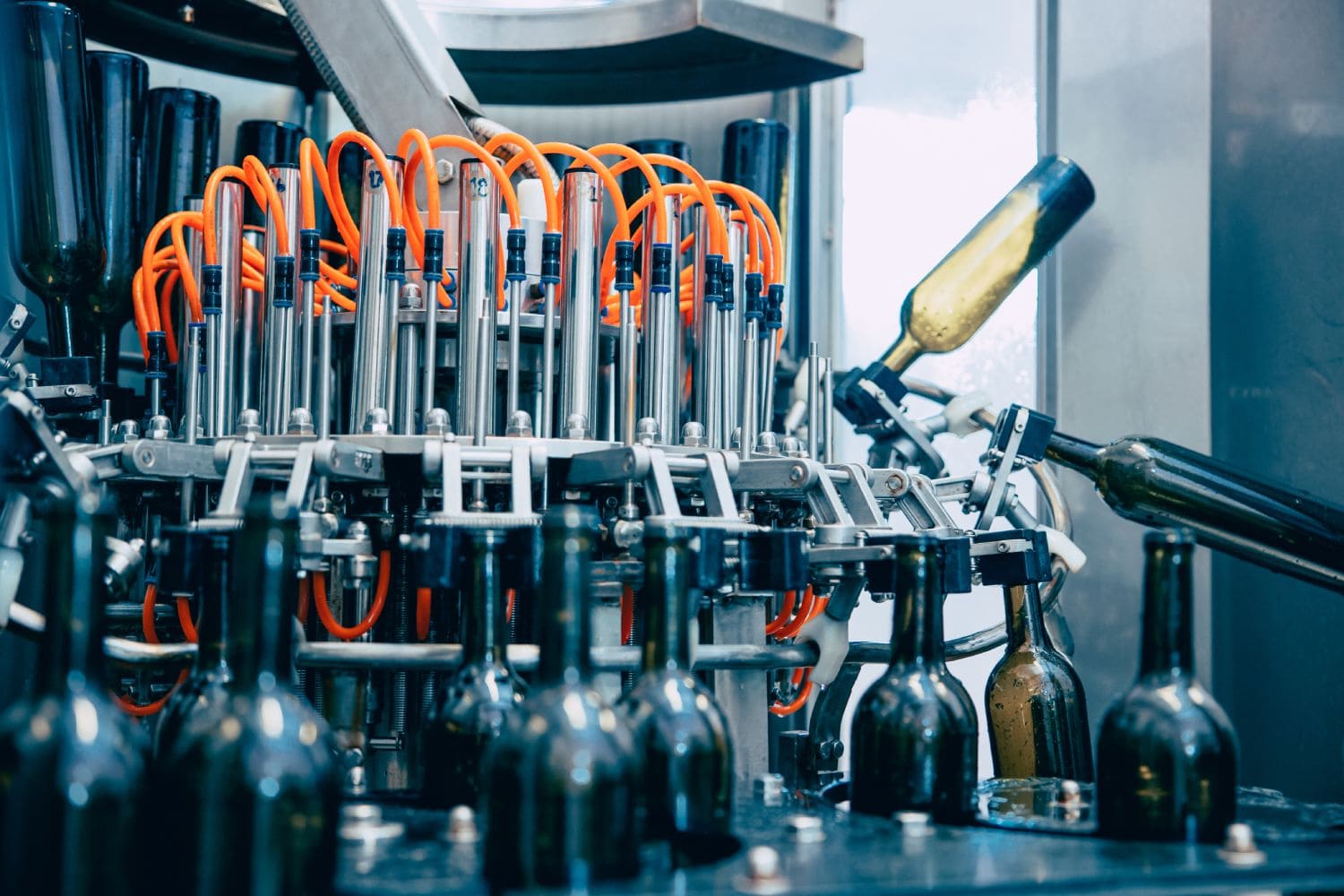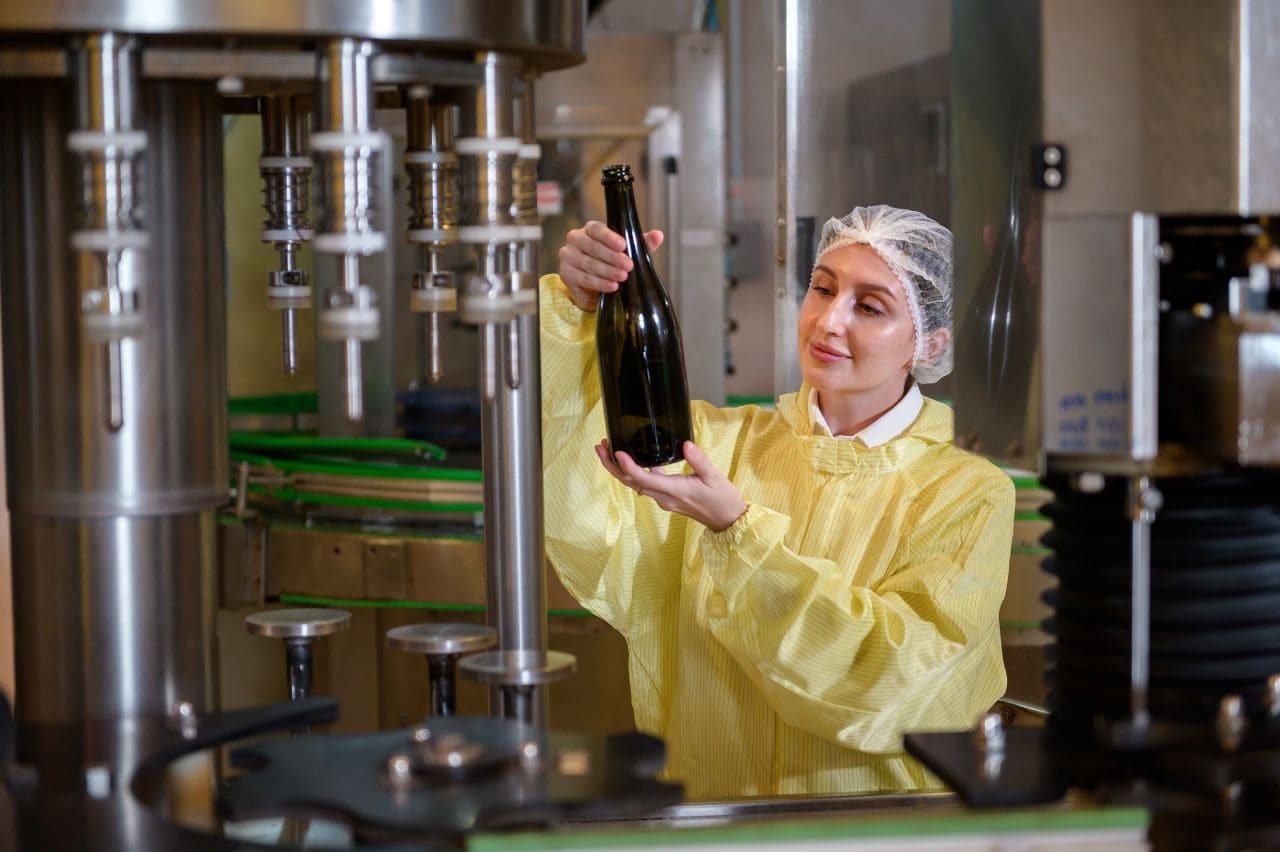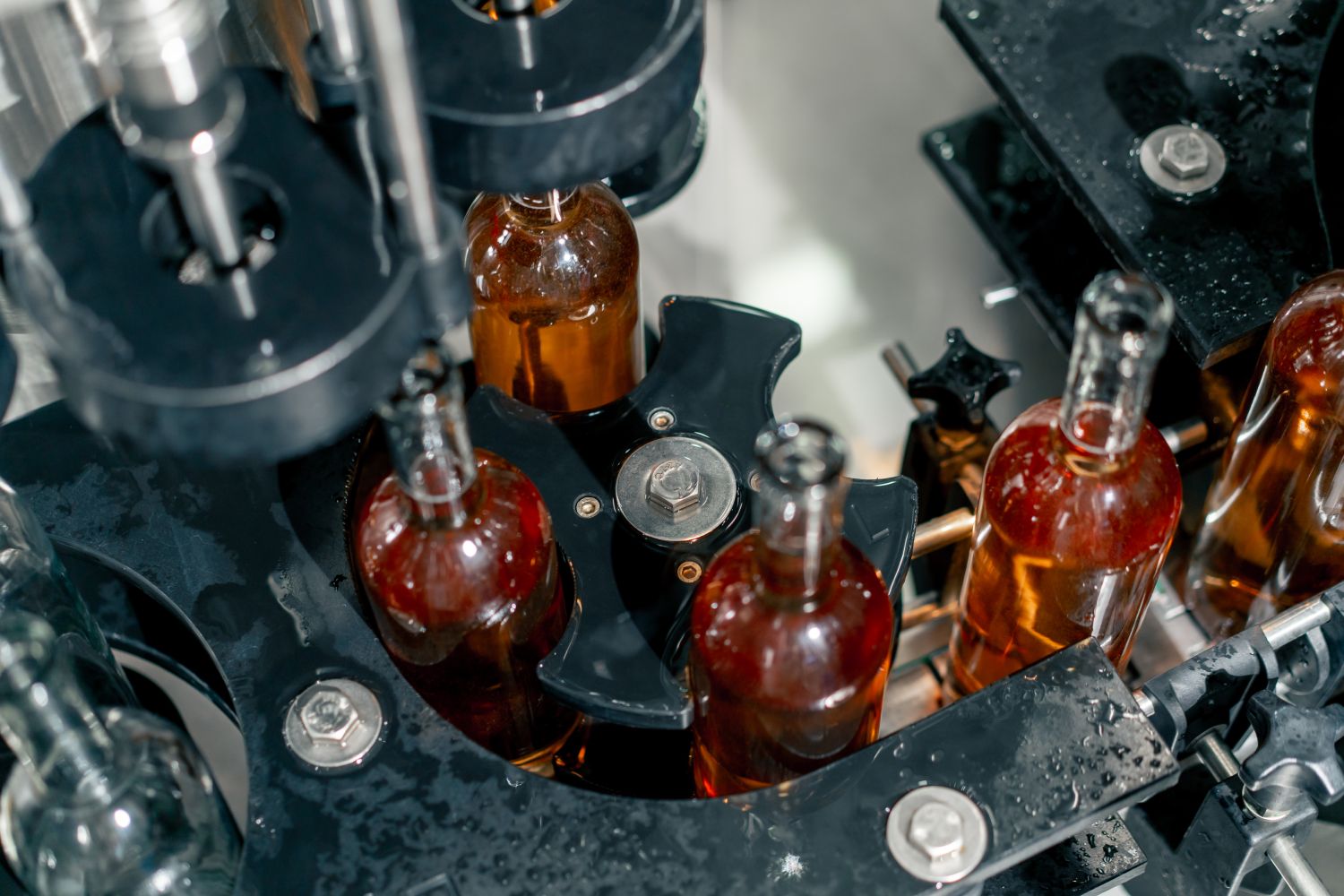- Products
- Parts
- Liquid Packaging Line Services
- Used & Rebuilt Equipment
- Used Bottle Cleaning & Rinsing Machines
- Used Bottle Coders
- Used Bottle Elevators & Cap Feeders
- Used Bottle Unscramblers
- Used Cappers & Bottle Capping Equipment
- Used Case Erectors
- Used Case Packers
- Used Case Sealers & Tapers
- Used Check Weighers
- Used & Rebuilt Conveyors
- Used Heat Shrink Tunnels
- Used Hot Melt Glue Machines
- Used Liquid Filling Machines
- Used Neck Banding & Sleeving Machines
- Other
- Machine Types
- Industries We Serve
- Trade Shows
 Loading... Please wait...
Loading... Please wait...Blog
How to Build the Perfect Bottling Line for Wine Production
Posted on 15th Aug 2025
 Crafting an efficient and high-quality wine bottling line is both a science and an art. Unlike other beverages, wine demands precision, sanitation, and presentation—all while maintaining the authenticity and integrity of the product. From the gentle handling of delicate vintages to preserving flavor and aroma, every step in the bottling process must be optimized with care.
Crafting an efficient and high-quality wine bottling line is both a science and an art. Unlike other beverages, wine demands precision, sanitation, and presentation—all while maintaining the authenticity and integrity of the product. From the gentle handling of delicate vintages to preserving flavor and aroma, every step in the bottling process must be optimized with care.
Whether you’re a growing boutique winery or a large-scale producer seeking to scale operations, understanding how to design the ideal wine bottling line is an important step toward success.
What Makes a Wine Bottling Line Unique
Wine bottling lines stand apart from those used for other beverages due to the delicate nature of wine itself. Wine is highly sensitive to oxidation, temperature fluctuations, and microbial contamination. Because of these characteristics, bottling equipment must minimize air exposure, maintain strict hygiene standards, and allow for gentle product handling to protect the wine’s character.
Additionally, wine packaging is often part of a brand’s luxury identity, which means bottling lines must also support high-end aesthetics through precise labeling, foiling, and handling of diverse bottle and closure types, including corks, screw caps, and synthetic options.
Core Components of Bottling Lines for Wine: What You Need & Why
A well-designed wine bottling line integrates several specialized machines that work together to preserve product quality and optimize throughput. Each component plays a critical role in ensuring cleanliness, precision, and consistency from the moment the empty bottle enters the line to the final packed case ready for shipment.
Rinsing or Cleaning Machines
Ensuring the bottles are sterile before filling is essential for maintaining the wine’s integrity and shelf life, and rinsing or cleaning machines are the first line of defense against contamination. They sanitize empty bottles using filtered water, air, or a specialized cleaning solution to remove dust, debris, and residues from storage or shipping. Some systems use ionized air rinsing to avoid introducing additional moisture into the bottles.
Filling Machines
Wine fillers must deliver precise volumes of product while minimizing agitation and exposure to oxygen. Gravity or vacuum fillers are often preferred because they reduce foaming and ensure a smooth fill. These machines are typically designed to accommodate various bottle sizes and styles. Some advanced fillers feature nitrogen purging systems to displace oxygen in the bottle before and after filling.
Corking Machines
Corking machines insert natural or synthetic corks under vacuum conditions to prevent oxygen intrusion. The vacuum process removes air from the neck of the bottle before sealing, which helps preserve flavor and aroma. Proper compression and insertion of the cork are required to ensure a tight seal and avoid leakage. Some systems also accommodate multiple cork types with easy changeover features.
Capsuling or Foiling Machines
Capsuling or foiling machines apply foil or capsules over the neck and cork to enhance visual appeal and provide tamper evidence. Heat-shrink or spinning technologies are used depending on the capsule material. Consistent application is key to maintaining a polished and professional appearance. This step often contributes significantly to brand presentation on store shelves.
Sealing Machines
For wineries using screw caps or synthetic closures, sealing machines ensure uniform torque and secure closure. These machines must accommodate different cap materials and dimensions. Precision is vital to prevent leaks and maintain product freshness. Adjustable torque controls are often used to fine-tune sealing based on closure type.
Labeling Machines
Wine bottles often feature front, back, and sometimes neck or medal labels, all of which require high-precision application. Labeling machines align labels perfectly, even on tapered or non-standard bottles. Many systems allow for quick changes between label types and bottle formats. Accuracy and consistency are crucial for brand image and regulatory compliance.
Packing Systems
Automated or semi-automated packing systems group bottles into cases for transport and storage. These machines streamline the packaging process, reducing manual labor and increasing efficiency. They can include case erectors, inserters, sealers, and palletizers, depending on production scale. Proper packing prevents damage during transit and ensures efficient warehouse handling.

Types of Wine Bottling Lines: Manual vs. Semi-Automatic vs. Automatic
Choosing the right type of bottling line depends on your winery’s production volume, budget, and long-term goals. Each option—manual, semi-automatic, and automatic—offers distinct advantages and challenges in terms of labor, output, and scalability.
Manual Bottling Lines
Manual lines are ideal for small wineries or limited production runs where hands-on control is valued. Operators perform most tasks, such as filling, corking, and labeling by hand, which allows for flexibility and a personal touch.
However, manual bottling is time-consuming and labor-intensive, limiting throughput. It is best suited for artisanal or custom-label projects where quality and customization outweigh speed.
Semi-Automatic Bottling Lines
Semi-automatic lines automate critical steps like filling and corking while still requiring manual intervention for tasks such as labeling or packing. They offer a good balance between cost-efficiency and productivity for mid-sized producers. Semi-automatic lines also reduce human error and increase consistency compared to manual lines.
With the right layout, they can often be upgraded later to accommodate growing production needs.
Automatic Bottling Lines
Fully automatic lines handle every stage of the bottling process, from rinsing to case packing with minimal human involvement. These systems are designed for high-volume operations and prioritize speed, consistency, and hygiene.
Although they require a higher upfront investment, automatic lines deliver long-term return on investment (ROI) through labor savings and production efficiency. Advanced models also include real-time monitoring and quality control systems to ensure maximum uptime.
How to Design Bottling Lines for Wine That Scale: 7 Key Things to Consider
Designing a wine bottling line involves evaluating various logistical, operational, and technical factors to ensure long-term performance. Careful planning in these areas can prevent costly errors, support scalability, and align the bottling process with your winery’s goals and branding.
1. Production Capacity
Your production volume will dictate the type of bottling line you need. Small wineries may be well-served by manual or semi-automatic systems, while larger operations require high-capacity automatic lines.
Always consider future growth and choose equipment that can scale with your production. Planning ahead avoids bottlenecks and costly retrofits.
2. Bottle Type & Shape
Wine bottles come in a wide array of shapes and sizes, including Bordeaux, Burgundy, and specialty formats. Your equipment must be compatible with these dimensions to ensure smooth transitions between machines. Irregularly shaped bottles may require custom handling solutions. Keep in mind that branding and presentation can also influence bottle selection.
3. Closure Type
From traditional corks to screw caps and synthetic options, closure type significantly affects your equipment choices. Corking machines, cappers, and sealers must be tailored to your selected closure system. Consistency and reliability are critical to maintaining wine quality and consumer confidence.
If you plan to offer multiple closure options, seek versatile equipment with easy changeovers.
4. Budget
Your budget determines not only the level of automation but also the durability and features of the machinery. Investing in quality equipment may require more upfront capital but pays off through efficiency and lower maintenance costs.
Consider the total cost of ownership, including energy use, replacement parts, and service. The goal is to strike a balance between quality and affordability.
5. Space Needs
Bottling lines must be laid out efficiently to optimize space and workflow. Evaluate your facility’s dimensions and identify any constraints such as ceiling height, floor space, or access points. Ensure adequate room for operators, cleaning access, and future expansion.
Modular equipment can help maximize flexibility in tight spaces.
6. Maintenance & Cleaning Requirements
Easy-to-clean equipment reduces downtime and supports product safety and compliance. Look for designs with minimal moving parts, smooth surfaces, and tool-less disassembly.
Regular maintenance should be straightforward to perform with clear documentation and support. Neglecting this consideration can lead to frequent repairs and operational inefficiencies.
7. Manufacturer Reputation
Partnering with a reputable manufacturer ensures reliable performance, support, and longevity of your investment. Read reviews, request references, and evaluate customer service responsiveness. Trusted suppliers often offer training, spare parts, and upgrades, so a strong relationship with your equipment provider is invaluable for long-term success.

Must-Have Equipment for a High-Performance Wine Bottling Line
Choosing the right equipment is crucial for maintaining wine quality, achieving production targets, and enhancing operational efficiency. Here are a few of the core pieces of equipment that form the backbone of a high-performing wine bottling line.
Bottle Rinser & Sterilizer
Clean bottles are the foundation for preserving wine quality and flavor. Bottle rinser and sterilizer machines ensure each wine bottle is sanitized before filling to prevent contamination. It typically uses filtered water, ozone, or ionized air to rinse and sterilize the interior of bottles.
Gravity or Vacuum Filler
Filling machines gently transfer wine into bottles with precision. Gravity fillers use natural flow, while vacuum fillers reduce oxygen exposure, preserving the wine’s integrity. They are essential for maintaining accurate fill levels and minimizing product loss.
Vacuum Corker or Screw Capper
Depending on the closure type, these machines apply either a cork under vacuum conditions or a screw cap with precise torque. This process ensures a tight seal and prevents oxygen ingress. The right closure system helps extend shelf life and protect the wine’s profile.
Capsule Applicator or Foiler
Aesthetics and tamper-evidence are both improved with capsules or foil wraps applied to the neck. These machines uniformly apply and secure the materials using heat or spinning technology. Thanks to their added visual appeal, they contribute to branding and product presentation.
Labeling Machine (Front & Back)
Consistent labeling supports quality assurance and visual appeal. Labeling machines apply front and back labels with precision to meet brand and regulatory requirements. They accommodate different label shapes and bottle styles, including tapered bottles.
Inspection Systems (Fill Level, Label Alignment, Cap Integrity)
Inspection systems automatically check for fill level accuracy, label placement, and proper sealing. They help identify defects and reduce waste. Incorporating inspection safeguards ensures only top-quality bottles reach customers.
Conveyors & Accumulation Tables
Conveyors and accumulation table components facilitate smooth bottle movement between machines and allow accumulation for operational flexibility. They help maintain consistent flow and reduce bottlenecks. Therefore, proper conveyor integration is essential for line efficiency.
Case Packers & Palletizers (for High-Volume Lines)
Case packers and palletizers machines automate the final stages of bottling by grouping, boxing, and stacking bottles. They reduce manual labor and improve packaging speed. For high-output wineries, these systems streamline shipping readiness and warehouse operations.
Build the Best Bottling Line for Wine Production with Change Parts
Creating the perfect wine bottling line is a nuanced process that blends technology, product care, and operational strategy. By understanding the unique needs of wine, carefully selecting equipment, and planning for growth, wineries can build efficient bottling lines that uphold product quality and brand integrity.
Whether you’re investing in a fully automated line or a flexible semi-automatic setup, the right choices can yield long-term efficiency and exceptional product presentation.
At Change Parts, we specialize in supplying precision-engineered components and custom bottling solutions tailored for wine producers of all sizes. Let our expertise guide your next investment. Contact us today to explore our full range of bottling equipment or request a quote to discover how we can help you build a bottling line that meets your production goals and exceeds your expectations.

Types of Capping Machines: Which One Is Right for Your Packaging Line?
Behind every securely sealed bottle, jar, or can is a crucial step that often goes unnoticed: capping. While packaging design and labeling get most of the attention, the cap is what truly protects the product, ensures safety, and preserves shelf life. From bottling beverages and sealing pharmaceutical containers to packaging automotive fluids, a reliable capping [...]

The Ultimate Guide to the Bottle Capping Process
Bottle capping is one of the final—but most critical—steps in the packaging process. A secure and well-executed cap makes your product shelf-ready, protects product integrity, extends shelf life, and builds consumer trust. Whether you’re bottling beverages, pharmaceuticals, cosmetics, cleaning products, or another bottled product, your capping system plays a vital role in efficiency, quality assurance, [...]
Benefits of Buying Used or Rebuilt Equipment
Most companies and businesses only think about purchasing new equipment when planning to expand their capacities. However, new equipment is costly, even for international enterprises that earn large amounts of profit. When thinking about adding more equipment, consider purchasing used or rebuilt equipment. It can provide your business with numerous advantages you maybe weren’t even aware [...]
Why Line Integration Is Important to Your Operations and the Benefits It Provides
Many companies have been using the packaging lines for a long time. The main priority for every factory should be a safe and well-functioning packaging line because it’s crucial for overall productivity and work efficiency. Of course, you have to maintain its work process because otherwise, you can face many issues.These manufacturing machines are complex [...]
Used vs. Rebuilt Equipment: Which Is Better for You?
Companies belonging to all kinds of industries can experience rapid growth in popularity and overall success. Although this suddenly increases their production and manufacturing needs, they still don’t earn enough profit to invest in brand new equipment. Purchasing used and rebuilt equipment is probably the smartest business move in these situations. While these two terms come [...]
Why Changing Your Filling Machine/Filling Line Parts Are a Good Idea
Machine maintenance is one of the pillars of any production industry, especially as machines age. As time passes, wear and tear take their toll on the machines, which means you’ll have to make costly repairs or upgrades. Luckily, there are more than a couple of ways you can make your machinery run as smoothly as [...]
How is Change Parts Is a Good Solution for Upgrading Equipment Rather Than Purchasing New?
Did you know you don’t always need to spend a lot of money to make your current production more efficient? More often than not, the solution can be as simple as upgrading your existing machines. An upgrade can help you save quite a lot of money, all while keeping your machines in perfect running order. Any [...]
Recent Posts
- » How to Build the Perfect Bottling Line for Wine Production
- » Types of Capping Machines: Which One Is Right for Your Packaging Line?
- » The Ultimate Guide to the Bottle Capping Process
- » Benefits of Buying Used or Rebuilt Equipment
- » Why Line Integration Is Important to Your Operations and the Benefits It Provides




